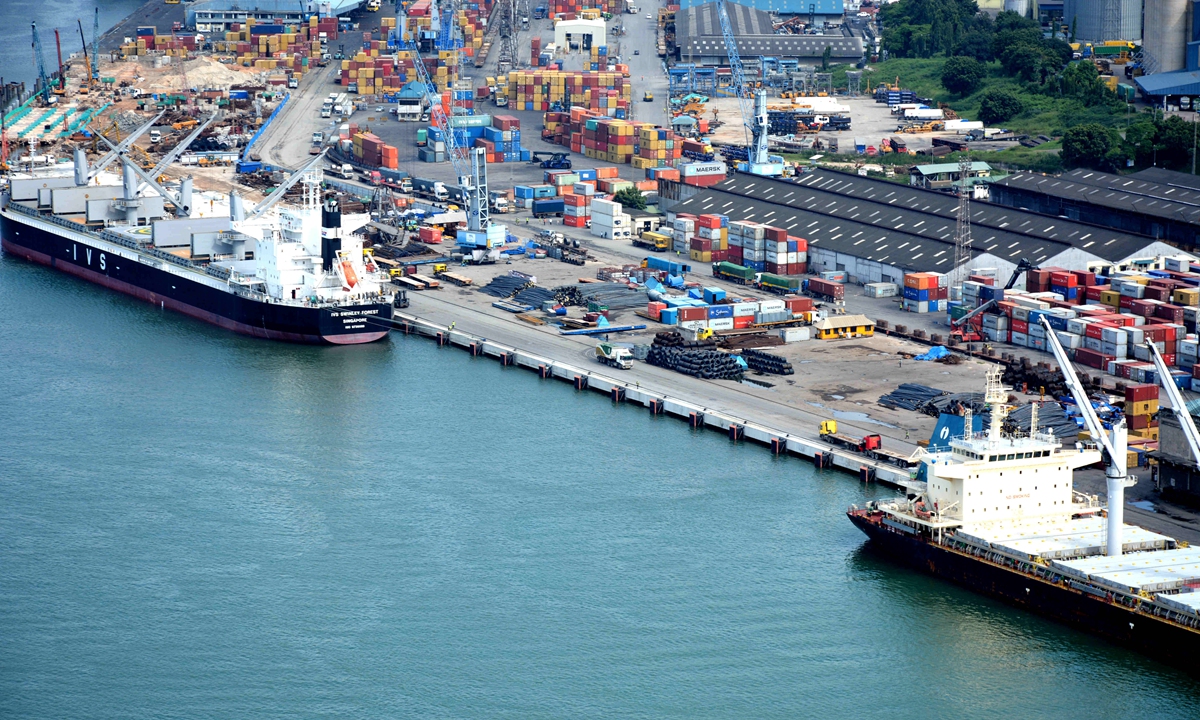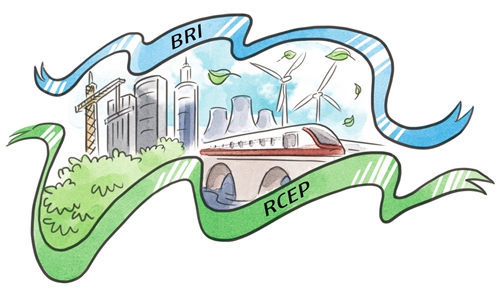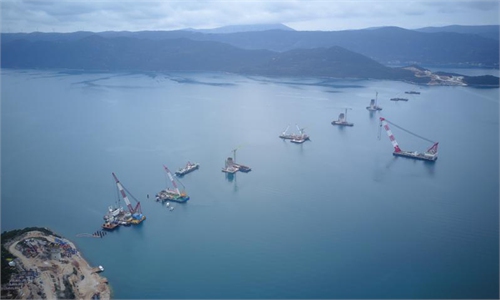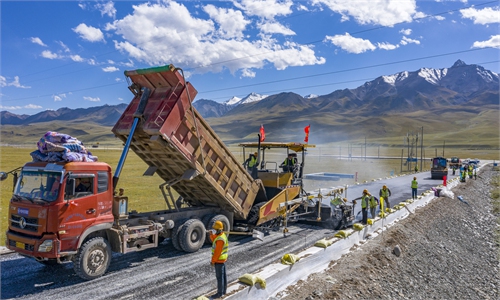BRI bridges a channel for medical supplies, ensures stability of supply chains amid hard times
China signs 202 deals with 138 countries, 31 global organizations

The construction site of the Belt and Road Initiative project to upgrade the Dar es Salaam Port in Dar es Salaam, Tanzania on April 9. In July 2017, Tanzanian President John Magufuli officially launched the project to upgrade the east African nation's largest port, which mainly involves the upgrade of seven existing berths and the building of a new berth. Photo: Xinhua
After chairing the port customs for China-Europe freight train in "the world supermarket" Yiwu in East China's Zhejiang Province, Zhao Hengchao said this year's demand for cross-border freight trains was unprecedented, with the total freight volume between China and Europe growing nearly 105 percent year-on-year, a reflection of close relation between China and the countries along the Belt and Road Initiative (BRI).
Going against the COVID-19 outbreak that is out of control in many countries and regions, intensified by the global complexity created by the unilateralism of the Trump administration, the BRI, which has been questioned by the West for its sustainability over trade and political trusts, has bucked the trend and helped the countries joining the project combat the virus, stabilize economy and protect people's livelihood.
Driven by demand, China's direct investment in Belt and Road partner countries has grown by 30 percent over the first three quarters this year compared with 2019, against the backdrop of global economic recession, playing an important role in invigorating the regional economic cycle and promoting global economic recovery.
Buck the trend
Behind the growth is a mix of opportunities and challenges for the countries involved in BRI, especially when the West has been relentlessly politicizing the initiative and questioning its value and sustainability.
"For some leading partner countries, the pressure on health and coronavirus prevention and economic development is enormous, because of the virus, countries including some partner countries also made some unfriendly moves toward China, such as demanding compensation and debt relief from China, which have brought new difficulties for the BRI," Zhang Jianping, director of the Institute for West Asia and Africa under the Ministry of Commerce, told the Global Times on Sunday.
Although some developing countries are facing hurdles in debt repayment due to the coronavirus and a global economic recession, not a single BRI partner country has agreed with the claim of the so-called debt traps, said Chinese Foreign Ministry spokesperson Wang Wenbin on December 21.
Meanwhile, by taking into account the difficulties of some developing countries over the pandemic fallout, the Chinese government has canceled interest-free loans owed by African countries due to mature by the end of 2020, which makes it the biggest contributor to the G20 Debt Service Suspension Initiative, Wang added at the same regular press conference.
Another major challenge for the BRI this year is that due to the spreading of COVID-19, personnel exchanges have been restricted, and activities related to the economic, trade cooperation and infrastructure connectivity along the BRI have been disrupted, analysts said.
In responding to the hardships, China has established so-called fast green channels to facilitate priority transportation of people and goods with many countries, especially the Belt and Road partners.
While much of the world remains in a deep recession throughout the pandemic with stores closing, factories shutting down and transport disrupted, China's effective containment of the outbreak and the fast resumption have become a key pillar for the sustainable economic and trade development for the BRI countries, whether in terms of bridging a "health channel" for the medical supplies or ensuring the stability of supply chains for providing daily necessities.
Over the first half of this year, China's exports of medical supplies, including masks, protective suits and ventilators, to countries along the Health Silk Road, increased by 3.4 times, boosting China's overall export to those countries up 2.2 percentage points.
Medical supplies are just one part of the whole picture of BRI' resilience in hard times. With China becoming a driving force for the world economy, its trade value with countries along the Belt and Road achieved $963.42 billion in the first three quarters, 0.8 percentage points higher than that of the national level, the People's Daily said in a report.
Non-financial direct investment by Chinese enterprises in the countries along the BRI also showed a positive trend with an increase of 29.7 percent year-on-year in the first three quarters, according to the Ministry of Commerce.
In the context of the booming trade and investment, China has signed 202 cooperation agreements with 138 countries and 31 international organizations to jointly build the BRI, according to the Foreign Ministry on December 18.
"Thanks to China's rapid economic recovery and proactive opening-up, as well as the solid foundation laid over the past seven years, cooperation on the BRI has shown great resilience in the face of the coronavirus this year," Meng Wei, spokesperson from National Development and Reform Commission, said at a regular press conference in November.

New prosperity
Even though the BRI has been on an upward trend, experts said that the complexity of the current international environment and ongoing outbreaks of COVID-19 mean that the Belt and Road will have to find unique solutions amid rising political and economic risks.
"Although the tensions over China-US relations may ease under the new Biden administration after being at the lowest ebb under Trump, the US government will continue to take a confrontational approach by bringing in more challenges to the BRI, including the competitions over corresponding projects with China in developing countries," Wang Yongzhong, a research fellow with the Institute of World Economics and Politics at the Chinese Academy of Social Sciences, told the Global Times on Sunday.
In order to reduce risk, China should pursue quality instead of quantity agenda and focus more on the efficiency of operations for existing projects and do not rush to develop new ones, Wang said.
In the face of the rising demand for mineral resources, China may speed up investment in countries in a bid to tackle need for improved access to scarce resources by strengthening supply chain management, this may include Morocco's phosphate rock mine and iron ore mine in the Republic of Guinea and some Latin American countries, Wang said.
The BRI may also find more opportunity in the regional cooperation, with China actively building closer ties with ASEAN counties, which have become China's largest trading bloc, exceeding the EU in 2020, he added.
"Both sides share ever stronger cooperation across the China-ASEAN Free Trade Area and the cooperation on international industrial capacity including the investment of industrial zones, which helped to form a reciprocal effect in bilateral trade," said Zhang, noting that the RCEP in which ASEAN countries and those in the neighboring region participated will be the economic center of gravity of not just the Belt and Road but also the global economy next year.



